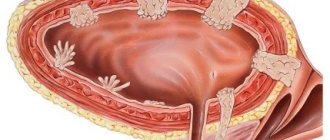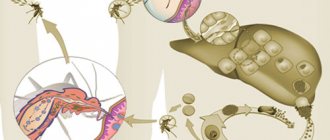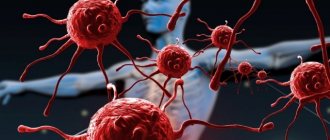Not yet diabetes - what is the reason for the changes?
Prediabetes is a special condition defined as the border between the normal functioning of the body and the development of diabetes mellitus. At this point, the pancreas produces insulin, but production volumes are slightly reduced. Patients whose blood sugar levels are elevated after meals are at risk of developing type 2 diabetes.
There is no tragedy in prediabetes, because this condition is reversible, but the result depends entirely on the patient’s own desire not to face an incurable disease. In order to maintain the quality of life and stabilize blood sugar levels, a person will have to work on himself: a healthy lifestyle, sports and proper nutrition - these rules will help to get a positive result.
Recently, the situation has worsened; a similar disorder is detected in children, and no less often than in adults. What is the reason? Such a disorder may be a consequence of serious surgery or previous infectious diseases. Type 2 diabetes develops quite slowly, metabolic disorders progress over decades.
Can prediabetes be cured?
It is definitely possible, but only if the patient has perseverance, willpower and desire to live a healthy life. However, statistics show that the indicators for prediabetes are disappointing.
Every year, 10% of patients with previously diagnosed stage zero join the group of patients with type 2 diabetes. Why does this happen if there is a way out, and the technique that ensures recovery is quite simple? Unfortunately, patients often underestimate the danger and do not know what diabetes is and how to live with it.
Characteristic manifestations: when should you worry?
Feeling depressed – when you need to sound the alarm.
The symptoms of prediabetes are mild - this is the basis of the problem. If the majority of people suffering from diabetes had at one time paid attention to some change in their well-being, the prevalence of the disease would have been somewhat less.
Prediabetes, the symptoms of which can manifest with varying intensity, can be characterized by the following changes in well-being:
- A feeling of dryness in the mouth, a significant increase in the volume of fluid consumed. This reaction is explained by the fact that when the concentration of glucose increases, the blood thickens, and the body tries to dilute it with a similar reaction. It is worth emphasizing that the symptom tends to intensify at the time of heavy physical and mental stress.
- Frequent urination. This manifestation is closely related to an increase in the volume of fluid consumed.
- Increasing feeling of hunger, especially at night and in the evening. Weight gain can be seen (in the photo there is an obese woman).
- Decreased performance, decreased concentration, memory changes.
- Often, after eating, the patient feels feverish, sweating increases, and dizziness increases. Such symptoms are signs of increased glucose concentration.
- Periodically occurring headaches that occur due to vasoconstriction.
- The manifestation of generalized itching is a consequence of problems with capillaries.
- Decreased quality of vision, appearance of spots before the eyes.
- Deterioration in sleep quality, people often experience insomnia.
- Hormonal imbalances. Girls and young women may notice changes in their menstrual cycle.
Excess weight as a factor predisposing to diabetes.
The listed signs of prediabetes are rarely specific. The most noticeable symptom is intense thirst. Patients often describe other characteristics as overwork, excessive exhaustion, or other health problems unrelated to diabetes.
Since it is extremely difficult to express the symptoms that characterize a dangerous condition, it is important to convey to people belonging to risk groups the need to undergo examinations.
Who's in danger?
Genetics as one of the factors.
The concept of prediabetes implies a condition of the human body in which metabolic disorders occur, sugar is several units above normal, however, a significant jump in indicators does not occur - that is, type 2 diabetes is not diagnosed.
Attention! Some time ago, such a change was defined as stage zero diabetes, but years later they gave it its own name.
It is extremely difficult, sometimes impossible, to independently identify the manifestation of pathology at the initial stage, however, there are techniques that will help confirm or refute the fact of the development of disorders.
The simplest and most common laboratory diagnostic methods are discussed in the table:
| What tests will help determine the diagnosis? | |
| Type of study | Description |
| Glucose tolerance test | The simplest and most accurate method used to diagnose diabetes. The technique is based on determining the rate of penetration of glucose into tissues. In the blood of a healthy person, the sugar content should normalize 2 hours after eating. In a patient with prediabetes, this figure may be 7.8 mmol/l. |
| Fasting glycemia | The diagnosis of diabetes is determined if fasting blood sugar is over 7 mmol/l, the normal value is 6 mmol/l. Prediabetes is diagnosed if the level fluctuates between 6-7 mmol/l. It should be noted that such definitions are suitable for studying venous blood. |
| Fasting insulin | The risk of prediabetes is high when insulin is detected in the blood at a concentration of more than 13 μIU/ml. |
| Glycated hemoglobin | For prediabetes, the figure is 5.7-6.4%. |
Laboratory diagnostics.
You should also pay attention to the fact that patients over 45 years of age who have some predisposition to developing diabetes should undergo such examinations at least once a year.
People with normal body weight over the age of 45 should be examined once every 3 years. For people with a risk factor for developing diabetes under the age of 45 – annually.
The risk of diabetes in women is slightly higher.
Attention! The manifestation of a symptom in the form of unquenchable thirst is a reason for an emergency visit to a specialist and an unscheduled laboratory test.
The list of factors that increase the risk of a disorder includes:
- high blood pressure, in which the indicators tend to be above 140/90, that is, stage 2 hypertension,
- increased concentration of cholesterol in the body,
- close people of the 1st line of kinship suffering from diabetes,
- the presence of gestational diabetes in a woman during any of her pregnancies,
- high birth weight
- lack of physical activity,
- hypoglycemia during hunger,
- taking certain medications for a long time,
- consumption of coffee and strong tea in volumes exceeding 600 ml per day,
- manifestation of skin rashes.
Hypertension increases the risk of developing diabetes.
Blood sugar levels in prediabetes
Experts recommend taking blood tests to check your sugar levels more often. Overweight people need to do this annually, especially after 45 years, and if they are of normal body weight and younger, once every 3-4 years.
Data from different laboratories may vary, so it is recommended to take the test in the same place.
Prediabetes is diagnosed if:
- On an empty stomach, blood sugar is from 5.5 to 6.9 mmol/l;
- A couple of hours after eating from 7.8 to 11 mmol/l;
- The level of glycohemoglobin (hemoglobin bound to glucose) is in the range of 5.8 – 6.5 mmol/l.
When diagnosing a disease, it is necessary to examine not only blood, but also urine to monitor kidney function at least once every 3 months.
What is the difference between diabetes and prediabetes, complications
Diagnostic features
If you identify symptoms that characterize prediabetes, or if you belong to a risk group, the patient should consult a doctor. The doctor will give the patient a referral for tests to confirm or refute doubts.
Attention! First of all, the patient should undergo a glucose tolerance test. The technique requires donating blood on an empty stomach.
The need to follow the rules for donating blood.
It is worth paying attention to the fact that blood sampling from the patient should be done no earlier than 10 hours after the last meal. After the patient consumes the glucose solution, 2 more measurements are taken - 1 hour after administration and 2 hours later.
The following factors are highly likely to distort test results:
- The instructions recommend that the patient refrain from any physical activity the day before the test.
- It is equally important to limit the influence of psycho-emotional factors.
- At the time of taking the test, the patient must be healthy: blood pressure and body temperature must be within normal limits.
- You should not smoke on the day of the test.
The video in this article will introduce readers to the features of diagnostics. The price of a full examination may vary slightly depending on the medical center chosen by the patient.
Causes of the disease
Prediabetes is a borderline state between a completely healthy body and diabetes mellitus. This disorder is characterized by the fact that the pancreas continues to produce insulin, but in much smaller quantities.
Persons with this disease are at very high risk of being diagnosed with type 2 diabetes. This disorder does not occur suddenly and is dangerous, however, it responds well to therapy.
Adverse factors that increase the risk of developing the disease:
- the presence of any stage of obesity;
- sedentary lifestyle;
- the course of gestational diabetes during pregnancy;
- the presence of a woman with an illness such as polycystic ovary syndrome;
- increased cholesterol or triglycerides in the blood;
- age over 45 years.
In a child, such a disease can result from:
- severe course of any infectious pathology;
- major surgery;
- poor nutrition.
In addition, the possibility of genetic predisposition cannot be ruled out, especially for those individuals with a family history of non-insulin-dependent diabetes. In such cases, people should regularly donate blood for general analysis.
Reasons provocateurs
It is generally accepted that people who are overweight and lead a sedentary lifestyle are at risk of developing diabetes mellitus. However, such a judgment is somewhat incorrect; the main reason is the body's response to insulin.
In this case, it is impossible to achieve an optimal glucose balance in the body. Carbohydrates consumed with food are converted into sugar, and glucose enters cells as an energy source. If the body's cells do not respond to the influence of insulin, they are unable to receive glucose.
The risk group includes:
- patients whose blood sugar fluctuates,
- obese people
- patients aged over 45-50 years,
- women suffering from polycystic ovary syndrome,
- patients with excessive concentrations of cholesterol in the blood.
Causes and symptoms of prediabetes
The cause of the disease is gradually developing insulin resistance. That is, the insulin produced by the pancreas becomes less effective, and the sugar level in the blood significantly exceeds the body's need for it. The blood becomes thicker and its flow through the vessels becomes more difficult. The cells lack energy, and exhaustion begins, both physical and psycho-emotional.
Trying to replenish the required amount of energy, the body begins to accelerate the breakdown of proteins, which in turn leads to a decrease in protective forces.
A person experiences these changes with the following symptoms, early signs of prediabetes:
- partial or complete loss of sleep;
- itching of the skin and intimate areas;
- dry skin and mucous membranes (dry mouth and burning tongue);
- frequent urination, especially at night. This symptom is preceded by increased thirst, which does not go away even after drinking;
- weakness, fatigue after simple exercises;
- sudden weight loss or gain without changing your diet;
- a constant feeling of hunger that stops briefly after eating. This is due to the inability of body cells to fully consume glucose from the bloodstream;
- rapid and long-lasting suppuration of wounds. Possible furunculosis;
- gums take on a loose appearance and bleed;
- loose teeth;
- difficult to treat thrush;
- decreased impotence;
- disruptions in the menstrual cycle;
- thickening and darkening of large folds of skin;
- leg cramps at night;
- blurred vision, periodic blurriness in front of the eyes;
- headache, migraine attacks;
- tingling in the arms and legs, cramps;
- periodic fainting;
- increased and often causeless irritability;
- the presence of acne, despite dry skin.
The impetus for the development of prediabetes is considered to be a hereditary predisposition, severe stress, a sedentary lifestyle, excess body weight, abuse of certain medications, hypertension, disruptions in the endocrine system, excessive consumption of sweets, complications after severe infections suffered in childhood.
It is worth thinking about the development of this pathology if gestational diabetes was diagnosed during pregnancy, a stillborn or a very large fetus was born, more than 4.5 kg.
Prediabetes usually does not show any obvious symptoms at its onset. But over time, a person still feels obvious discomfort and seeks help from an endocrinologist.
Can prediabetes be cured?
How to overcome the problem.
Treatment of prediabetes consists mainly of the patient's self-control and his ability to make the right choices.
At the initial stage of development of the disease, you will have to completely reconsider the rhythm of your usual life:
- completely quit nicotine addiction,
- eliminate the consumption of alcoholic beverages,
- review your usual daily menu,
- resort to physical activity.
Attention! The patient must make a choice that will determine his fate - a normal life in compliance with the rules of a healthy lifestyle and longevity, or subsequent adherence to the rules of surviving with diabetes.
Fighting excess weight and preventing diabetes.
It is worth paying attention to the fact that weight loss by 6-7% of total body weight in case of obesity reduces the likelihood of developing diabetes by 50%.
How to prevent the development of diabetes
If during the examination the patient was found to have impaired glucose tolerance, he should seek help from an endocrinologist. A specialist will help identify the optimal examination methods to determine the possibility of diabetes manifestations in the near future.
Medications are used only privately.
Attention! Women may be advised to undergo a complete hormonal examination.
Based on the data obtained, a treatment regimen will be determined, which necessarily includes several methods:
- physical exercise,
- dieting,
- medications for prediabetes.
Sports and diet are the basis of therapy, but it is possible to do without the use of medications if the indicators are not critical.
Patient menu
A complete cessation of nicotine addiction is necessary.
A diet for prediabetes requires adherence to the following rules:
- Refusal of foods that contain easily digestible carbohydrates. These products include baked goods, various sweets and desserts.
- It is worth limiting the consumption of all cereals, potatoes, carrots.
- Animal fats should be excluded from the diet.
- Beans, lentils and other legumes should be included in your diet.
- A complete abstinence from alcohol during the recovery period and adherence to strict restrictions in subsequent life are indicated.
- The maximum amount of calories consumed per day should not be more than 1500.
- A fractional meal regimen is shown. The total volume should be divided into 5-6 approaches.
The patient's menu should include:
- fresh vegetables and fruits,
- lean sea fish and seafood,
- cereals,
- the preferred spices are garlic, cinnamon, nutmeg,
- beef and poultry (except duck),
- high fat dairy products,
- egg white.
Patients should pay attention to the fact that such a diet will not only help stabilize sugar, but will also cleanse blood vessels of bad cholesterol.
The basis of the diet should be plant foods.
Attention should also be paid to the fact that a diet for prediabetes should be developed by a specialist - only basic recommendations are listed. We must not lose sight of the fact that persons suffering from hypertension, gastric ulcers, liver and kidney diseases must pay special attention to the preparation of their diet. Contacting a nutritionist will help prevent the risk of complications.
Sport
The benefits of Nordic walking.
Constant physical activity will help reduce excess weight and correct the vital activity of the body.
Attention! It should be noted that during physical activity there is a rapid decrease in glucose levels - it is consumed. However, exercise should become a habit.
It is important to pay attention to the following sports:
- jogging,
- cycling,
- dancing,
- tennis,
- swimming,
- Nordic walking,
- walking.
Recommendation! Any physical activity is useful, that is, an evening spent in front of the TV is prohibited. It’s better to spend your time usefully, go to a supermarket located away from home and buy healthy products.
Aqua aerobics promotes weight loss.
It is interesting to note that many patients with prediabetes complain of insomnia - this problem completely disappears after doing physical activity. The result will not be long in coming.
Compliance with precautionary rules is the main task of the patient. Loads should be increased gradually. The body should not experience excessive fatigue. If possible, the training plan should be discussed with a doctor; an endocrinologist familiar with the peculiarities of the course of the disease can also advise on this issue.
In most cases, lifestyle changes are enough to fully recover from prediabetes. Often, specialists try not to resort to the use of medications, due to the presence of a wide range of contraindications.
What to do if you are diagnosed with prediabetes
Further health and the likelihood of this borderline state developing into diabetes depends on compliance with the specialist’s recommendations and the patient’s wishes.
In most cases, lifestyle changes, a balanced diet and exercise normalize blood sugar levels and the patient’s well-being. Often this can be achieved even without taking medications.
Many patients are trying to find the answer to the question: how to prevent diabetes mellitus - identify this condition in a timely manner and change:
- carefully review your diet (reduce caloric intake, exclude sweets, desserts and fatty foods, sweet fruits and juices from the menu):
- get rid of bad habits;
- constantly monitor blood sugar , blood pressure, cholesterol and blood lipids;
- exercise daily.
This condition is completely curable and can prevent the development of diabetes.
The main problem of prediabetes and diabetes is the asymptomatic course of these pathological conditions in the first years after the changes in the body begin. Therefore, it is important to diagnose them in a timely manner, monitor blood counts (sugar, cholesterol, triglycerides), measure blood pressure, exclude sweet foods and desserts from the diet, and exercise (at least 150 hours a week). The diet should consist of fresh fruits, vegetable oils, nuts, and foods containing vitamin D.











